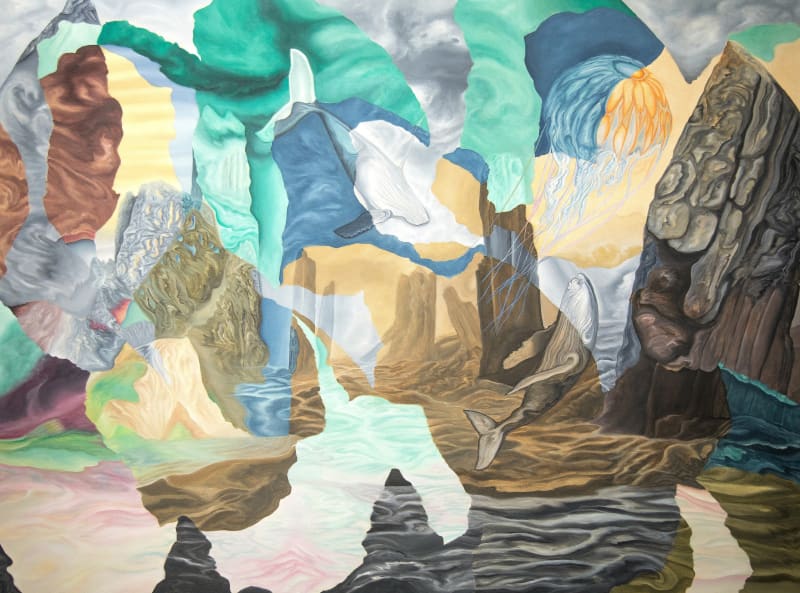Private View: Friday, 18th of October 2024, 6 - 8pm
Berlin
Through a swirling plane of vivid and translucent colours, we catch glimpses of wild animals, seascapes, jagged rocks, blooms of coral and skeletal trees. These layered, shifting landscapes are the work of Ghanaian, Mexican-born, Nigeria-based artist Kwadwo A. Asiedu whose practice examines the evolution of nature and our relationship to it. In its Wistful Shatter, his latest solo exhibition at Kristin Hjellegjerde Gallery, Berlin, presents a captivating new body of work that explores ideas of fracture and disconnect, but also of renewal and reparation. Bringing together elements from a diverse range of ecosystems, Asiedu contemplates a more harmonious form of coexistence between humankind and the natural world.
Asiedu originally trained as a photographer and draws on his vast archive as well as found images to create digital collages that he then translates onto the canvas. While previously he played with scale to abstract his source imagery and create dream-like landscapes, this latest series marks a shift towards the inclusion of more figurative elements that appear in contrast to the fluid brushstrokes and fragmented textures. These concrete details, Asiedu explains, are entry points that allow the viewer to recognise and situate themselves with the narrative on an emotional level, but they also highlight our complicity. For instance, in the painting Stem the Rising Tide a tiger sits at the bottom of the canvas staring into the distance. Before him is a jagged crop of ice illuminated in a pool of green – a vision perhaps of climate imbalance and with it, the endangerment of his species. Indeed, the tiger appears to already be fading from view while in the top right hand corner looms the spectral presence of a locust, a Biblical symbol of plague and destruction. As Asiedu notes, we, as humans, can see ourselves in both of these animals – as the destroyer and as the endangered species. In other words, we are responsible not only for the destruction of wildlife but of our own existence.
I’ve Seen Fire similarly uses animals – in this case a stallion and a pangolin – to add an emotional resonance to the composition. They are the ones who have seen and felt the effects of global warming most acutely and yet, they are also symbols of power and resilience. The horse is charging not away from danger but through the flames towards the viewer, while the pangolin, an animal who is at risk from extinction due to trafficking by humans, is not only the most concrete part of the image, the outline of its scales illuminated by a giant sun, but also blown up to a larger-than-life scale. Within this apocalyptic landscape, defined by acid-like tones, flames, charred and melting earth, their presence serves to highlight both nature’s suffering and adaptability in the face of human destruction.
This idea of mutability is also conveyed through Asiedu’s process in which he combines fragmented images to assemble new topographies but also through the recurring presence of mushrooms, which feature in almost all of the paintings in the series. ‘Fungal mycelia are highly intelligent: they exhibit decision-making and alter their developmental patterns in response to interactions with other organisms,’ he explains. ‘In my work, as in nature, they are small but mighty, integral to the foundations of our existing, and my painted, ecosystems.’ In other words, they offer a symbol of hope, of a world being remade – albeit one which may not include us. This unnerving truth lies at the crux of Asideu’s work and creates a sense of precarity throughout, but still, amid all the chaos and broken imagery, his blazing colours and shapeshifting forms hint at the potential for a radical kind of renewal and a world order in which nature, not us, rules supreme.


